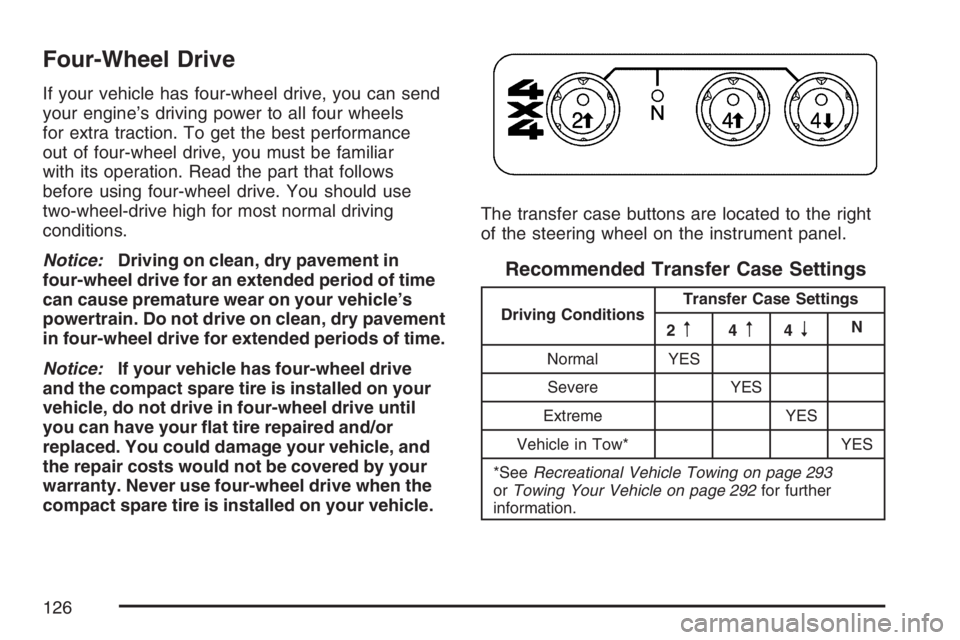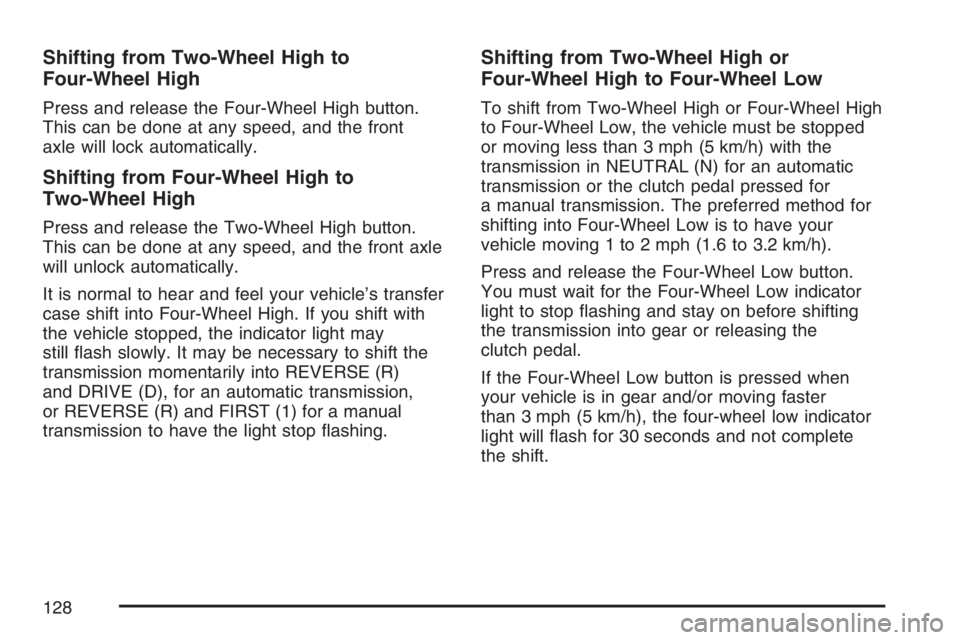2007 GMC CANYON four wheel drive
[x] Cancel search: four wheel drivePage 2 of 492

Service and Appearance Care
.................. 313
Service
................................................. 316
Fuel
...................................................... 318
Checking Things Under the Hood
......... 323
Rear Axle
............................................. 359
Four-Wheel Drive
.................................. 359
Front Axle
............................................ 360
Bulb Replacement
................................ 361
Windshield Wiper Blade Replacement
... 367
Tires
..................................................... 369
Appearance Care
.................................. 415Vehicle Identi�cation
............................. 424
Electrical System
.................................. 425
Capacities and Speci�cations
................ 430
Maintenance Schedule
.............................. 433
Maintenance Schedule
.......................... 433
Customer Assistance Information
............. 455
Customer Assistance and Information
..... 456
Reporting Safety Defects
...................... 474
Index
.......................................................... 477
2
Page 97 of 492

Keys.............................................................. 99
Remote Keyless Entry (RKE) System........ 100
Remote Keyless Entry (RKE)
System Operation.................................. 101
Doors and Locks........................................ 104
Door Locks................................................ 104
Power Door Locks..................................... 105
Programmable Automatic Door Locks........ 106
Rear Door Security Locks (Crew Cab)....... 106
Lockout Protection..................................... 107
Rear Doors (Extended Cab)...................... 107
Tailgate..................................................... 108
Windows...................................................... 110
Manual Windows....................................... 110
Power Windows........................................ 111
Sliding Rear Window................................. 112
Sun Visors................................................ 112
Theft-Deterrent Systems............................. 112
Content Theft-Deterrent............................. 112
Passlock
®.................................................. 114Starting and Operating Your Vehicle......... 115
New Vehicle Break-In................................ 115
Ignition Positions....................................... 116
Retained Accessory Power (RAP)............. 117
Starting the Engine.................................... 118
Engine Coolant Heater.............................. 119
Automatic Transmission Operation............. 120
Manual Transmission Operation................. 124
Four-Wheel Drive...................................... 126
Parking Brake........................................... 130
Shifting Into Park (P)
(Automatic Transmission)....................... 132
Shifting Out of Park (P)
(Automatic Transmission)....................... 134
Parking Your Vehicle
(Manual Transmission)........................... 134
Parking Over Things That Burn................. 135
Engine Exhaust......................................... 136
Running the Engine While Parked............. 137
Section 2 Features and Controls
97
Page 125 of 492

Notice:Shifting to REVERSE (R) while your
vehicle is moving forward could damage the
transmission. The repairs would not be covered
by your warranty. Shift to REVERSE (R) only
after your vehicle is stopped.
Use REVERSE (R), along with the parking brake,
for parking your vehicle.
Up-Shift Light
This light will show you
when to shift to the next
higher gear for best
fuel economy.
When this light comes on, you can shift to the next
higher gear if weather, road and traffic conditions
permit. For the best fuel economy, accelerate
slowly and shift when the light comes on.While you accelerate, it is normal for the light to
go on and off if you quickly change the position of
the accelerator. Ignore the shift light when you
downshift.
If your vehicle has four-wheel drive and has a
manual transmission, disregard the shift light when
the transfer case is in four-wheel low.
For more information, seeUp-Shift Light (Manual
Transmission) on page 185.Shift Speeds
{CAUTION:
If you skip a gear when you downshift,
you could lose control of your vehicle.
You could injure yourself or others.
Do not shift down more than one gear at
a time when you downshift.
125
Page 126 of 492

Four-Wheel Drive
If your vehicle has four-wheel drive, you can send
your engine’s driving power to all four wheels
for extra traction. To get the best performance
out of four-wheel drive, you must be familiar
with its operation. Read the part that follows
before using four-wheel drive. You should use
two-wheel-drive high for most normal driving
conditions.
Notice:Driving on clean, dry pavement in
four-wheel drive for an extended period of time
can cause premature wear on your vehicle’s
powertrain. Do not drive on clean, dry pavement
in four-wheel drive for extended periods of time.
Notice:If your vehicle has four-wheel drive
and the compact spare tire is installed on your
vehicle, do not drive in four-wheel drive until
you can have your �at tire repaired and/or
replaced. You could damage your vehicle, and
the repair costs would not be covered by your
warranty. Never use four-wheel drive when the
compact spare tire is installed on your vehicle.The transfer case buttons are located to the right
of the steering wheel on the instrument panel.
Recommended Transfer Case Settings
Driving ConditionsTransfer Case Settings
2m4m4nN
Normal YES
Severe YES
Extreme YES
Vehicle in Tow* YES
*SeeRecreational Vehicle Towing on page 293
orTowing Your Vehicle on page 292for further
information.
126
Page 127 of 492

Use these buttons to shift into and out of four-wheel
drive. You can choose from the following:
2
m(Two-Wheel High):This setting is for driving
in most street and highway situations. Your front
axle is not engaged in two-wheel drive.
{CAUTION:
Shifting the transfer case to NEUTRAL
can cause your vehicle to roll even if the
transmission is in PARK (P), or if you
have a manual transmission, even if you
are in gear. You or someone else could
be seriously injured. Be sure to set the
parking brake before placing the transfer
case in NEUTRAL. SeeParking Brake
on page 130.
N (NEUTRAL):Shift the vehicle’s transfer case to
NEUTRAL only when towing your vehicle.4
m(Four-Wheel High):This setting engages
your front axle to help drive your vehicle. Use
four-wheel high when you need extra traction, such
as on snowy or icy roads, or in most off-road
situations.
4
n(Four-Wheel Low):This setting also
engages your front axle to give you extra traction.
It sends the maximum power to all four wheels.
You might choose four-wheel low if you were
driving off-road in sand, mud, or deep snow and
while climbing or descending steep hills.
Indicator lights in the buttons show you which
setting you are in. The indicator lights will come on
brie�y when you turn on the ignition and one will
stay on the selected setting. If the lights do
not come on, you should take your vehicle in for
service. An indicator light will �ash while shifting.
It will stay on when the shift is completed.
If for some reason the transfer case does not shift,
it will return to the last chosen setting.
127
Page 128 of 492

Shifting from Two-Wheel High to
Four-Wheel High
Press and release the Four-Wheel High button.
This can be done at any speed, and the front
axle will lock automatically.
Shifting from Four-Wheel High to
Two-Wheel High
Press and release the Two-Wheel High button.
This can be done at any speed, and the front axle
will unlock automatically.
It is normal to hear and feel your vehicle’s transfer
case shift into Four-Wheel High. If you shift with
the vehicle stopped, the indicator light may
still �ash slowly. It may be necessary to shift the
transmission momentarily into REVERSE (R)
and DRIVE (D), for an automatic transmission,
or REVERSE (R) and FIRST (1) for a manual
transmission to have the light stop �ashing.
Shifting from Two-Wheel High or
Four-Wheel High to Four-Wheel Low
To shift from Two-Wheel High or Four-Wheel High
to Four-Wheel Low, the vehicle must be stopped
or moving less than 3 mph (5 km/h) with the
transmission in NEUTRAL (N) for an automatic
transmission or the clutch pedal pressed for
a manual transmission. The preferred method for
shifting into Four-Wheel Low is to have your
vehicle moving 1 to 2 mph (1.6 to 3.2 km/h).
Press and release the Four-Wheel Low button.
You must wait for the Four-Wheel Low indicator
light to stop �ashing and stay on before shifting
the transmission into gear or releasing the
clutch pedal.
If the Four-Wheel Low button is pressed when
your vehicle is in gear and/or moving faster
than 3 mph (5 km/h), the four-wheel low indicator
light will �ash for 30 seconds and not complete
the shift.
128
Page 129 of 492

Shifting from Four-Wheel Low to
Two-Wheel High or Four-Wheel High
To shift from Four-Wheel Low to Two-Wheel
High or Four-Wheel High, your vehicle must be
stopped or moving less than 3 mph (5 km/h)
with the transmission in NEUTRAL (N) for
an automatic transmission or the clutch pedal
engaged for a manual transmission. The preferred
method for shifting out of four-wheel low is to
have your vehicle moving 1 to 2 mph
(1.6 to 3.2 km/h).
Press and release the Four-Wheel High or
Two-Wheel High button. You must wait for the
Four-Wheel High or Two-Wheel High indicator
light to stop �ashing and stay on before shifting
the transmission into gear or releasing the
clutch pedal.
If the Four-Wheel High or Two-Wheel High button
is pressed when your vehicle is in gear and/or
moving faster than 3 mph (5km/h), the Four-Wheel
High or Two Wheel High indicator light will �ash
for 30 seconds but not complete the shift.
Shifting to NEUTRAL
Use NEUTRAL when you plan to tow your vehicle.
SeeRecreational Vehicle Towing on page 293
for towing instructions. To shift the transfer case
into NEUTRAL do the following:
1. Set the parking brake.
2. Start the vehicle.
3. Press the regular brake pedal and shift the
transmission in NEUTRAL (N), or press in
the clutch for vehicles with a manual
transmission.
4. Shift the transfer case to Two-Wheel High.
5. Press and hold the Two-Wheel High and
Four-Wheel Low buttons at the same time
for 10 seconds. The NEUTRAL (N) light
will come on when the transfer case shift to
NEUTRAL (N) is complete.
6. Press and hold the regular brake pedal and
shift the transmission to REVERSE (R) for
one second, then shift the transmission
to DRIVE (D) for one second, or FIRST (1) for
vehicles with manual transmissions, and let
out the clutch to insure the transfer case is in
NEUTRAL. If the vehicle is not in NEUTRAL,
repeat this procedure starting at Step 3.
129
Page 130 of 492

7. Turn the engine off by turning the key
to ACC (Accessory).
8. Place the transmission shift lever in
PARK (P), or FIRST (1) for vehicles that
have a manual transmission.
9. Turn the ignition to LOCK.
Shifting Out of NEUTRAL
After towing your vehicle, you will have to shift out
of NEUTRAL in order to drive. To shift out of
NEUTRAL, do the following:
1. Set the parking brake and apply the regular
brake pedal.
2. Start a vehicle with an automatic transmission
in PARK (P). Use FIRST (1) for vehicles with
a manual transmission.
3. Shift the transmission to NEUTRAL (N), or
press the clutch pedal for vehicles with a
manual transmission.
4. Press the button for the desired transfer case
shift position (Two-Wheel High, Four-Wheel
High, or Four-Wheel Low).
5. After the transfer case has shifted out of
NEUTRAL, the indicator light will go out.
6. Release the parking brake.
7. Shift the transmission to the desired position.
Parking Brake
The parking brake pedal
is located to the left of
the regular brake pedal,
near the driver’s door.
To set the parking brake, hold the regular brake
pedal down with your right foot. Push the
parking brake pedal down to its fully-applied
position with your left foot.
A chime will activate and the brake warning light,
located on the instrument panel, will �ash when the
parking brake is applied and the vehicle is moving
at least 3 mph (5 km/h) for at least three seconds.
The chime will deactivate and the light will turn off
when the parking brake is set and the vehicle is
moving below 3 mph (5 km/h). SeeBrake System
Warning Light on page 185.
130